Exploring animal diversity, one phylum each day! By @quark-nova
Last active 60 minutes ago
Don't wanna be here? Send us removal request.
Note
It's coming soon!
Will you ever do the phyla for plants and fungi etc
I might absolutely do them! Right now, I have the last few animal phyla planned, a phylum tournament (great thing with having 32 of them is that it's easy to do brackets), former phyla (Pogonophora, etc.), extinct phyla and unclassified oddities (vetulicolians, etc.), and then yes probably plants, fungi and protists!
10 notes
·
View notes
Note
Will you ever do the phyla for plants and fungi etc
I might absolutely do them! Right now, I have the last few animal phyla planned, a phylum tournament (great thing with having 32 of them is that it's easy to do brackets), former phyla (Pogonophora, etc.), extinct phyla and unclassified oddities (vetulicolians, etc.), and then yes probably plants, fungi and protists!
10 notes
·
View notes
Text
Sorry for the short interruption (again!) due to my internship report being due for Sunday - I'll be getting back at the regular post schedule on Monday, with posts about the four lophophorate phyla planned!
3 notes
·
View notes
Text
Phylum #23: Gastrotricha, the hairybellies!
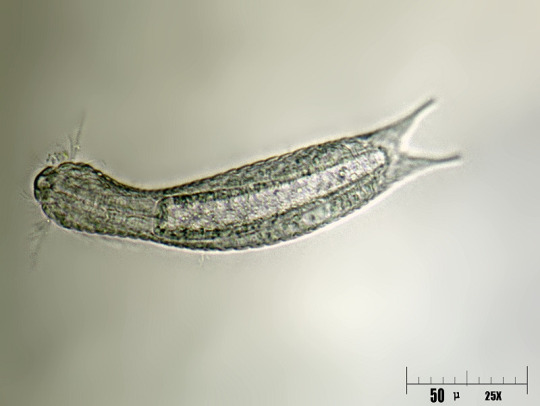
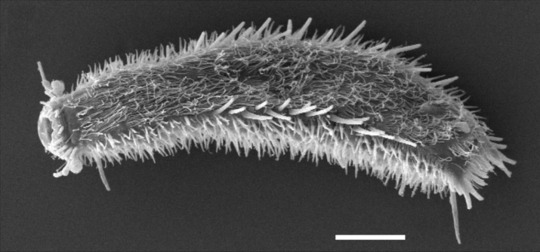
One more phylum of meiofauna, microscopic critters living in interstitial spaces! At most a few millimeters but often much smaller, hairybellies are named after the many cilia on their flat ventral surface!
These cilia work in tandem with adhesive tubes - especially on their characteristic forked tail, with which they crawl and slide inbetween sediments to eat, well, the kind of food a tiny guy would eat. Diatoms, bacteria and various kinds of organic matter are on the menu!
As often with these tiny critters, the rest of the body is quite simple - no circulatory or respiratory system, although a roughly differentiated head is visible. The latter often bears sensory cilia - microscopic whiskers! And they have scales covering their back - which is pretty unexpected for an animal that tiny!
Living gastrotrichs are divided in two groups. The chaetonotids have successfully reached both marine and freshwater environments, while macrodasyids stayed mostly marine, but developed two pores on either side of the neck, through which they shoot out water while eating. While extremely commonplace in today's sediments, they unfortunately lack a fossil record, making their relationship with other phyla yet more mysterious!


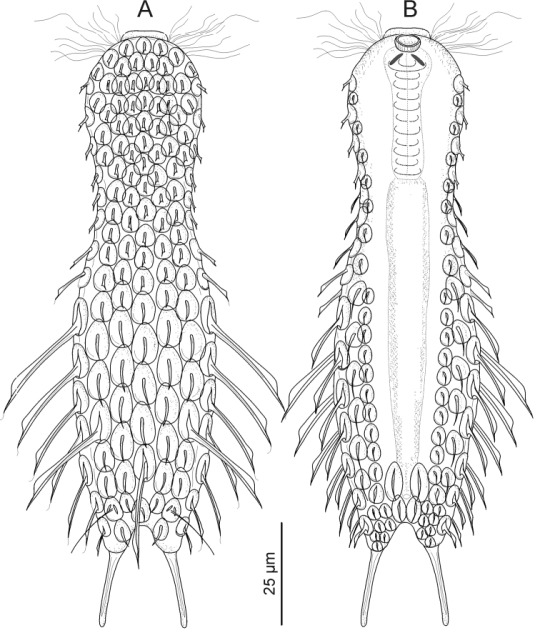
38 notes
·
View notes
Text
Phylum #23: Gastrotricha, the hairybellies!


One more phylum of meiofauna, microscopic critters living in interstitial spaces! At most a few millimeters but often much smaller, hairybellies are named after the many cilia on their flat ventral surface!
These cilia work in tandem with adhesive tubes - especially on their characteristic forked tail, with which they crawl and slide inbetween sediments to eat, well, the kind of food a tiny guy would eat. Diatoms, bacteria and various kinds of organic matter are on the menu!
As often with these tiny critters, the rest of the body is quite simple - no circulatory or respiratory system, although a roughly differentiated head is visible. The latter often bears sensory cilia - microscopic whiskers! And they have scales covering their back - which is pretty unexpected for an animal that tiny!
Living gastrotrichs are divided in two groups. The chaetonotids have successfully reached both marine and freshwater environments, while macrodasyids stayed mostly marine, but developed two pores on either side of the neck, through which they shoot out water while eating. While extremely commonplace in today's sediments, they unfortunately lack a fossil record, making their relationship with other phyla yet more mysterious!



#forms and phyla#gastrotricha#hairybelly#hairy belly#taxonomy#meiofauna#meioblr#that should be a tag
38 notes
·
View notes
Text
Phylum #22: Entoprocta, the goblet worms!

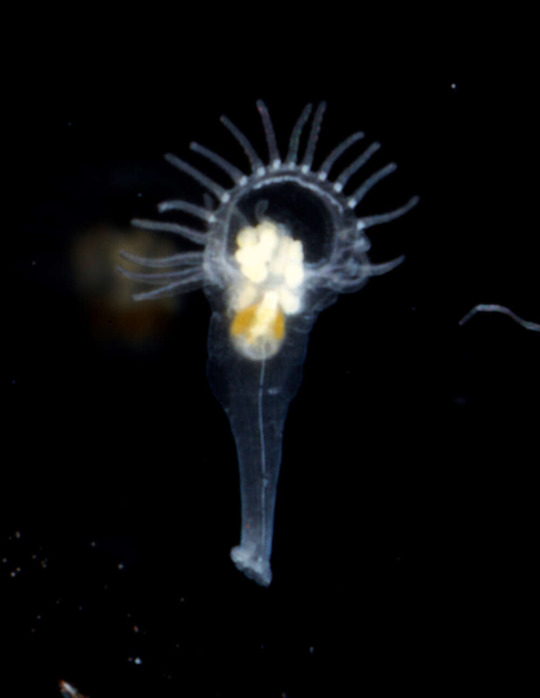
Despite their looks, these are not sea anemones, crinoids or bryozoans - these creatures have in fact been found to be mollusks' closest relatives! Although this part of the tree of life is in flux, entoproctan larva share the peculiar nervous system of mollusks, leading researchers to unite both in a single clade!
Entoproctans or kamptozoans, often referred to as goblets due to their stalked cup-like form, have a much simpler body plan than their relatives. A crown of tentacles at the top of the cup beats to bring a current through the U-shaped gut inside, passively filtering food particles. And that's it!
Goblets often live in massive colonies, with new ones budding from the stalks of previously-established ones. These stalks actually serve a triple function, also extending the reach and allowing them to share nutrients. However, a few species are free-living and solitary, crawling with their foot (their equivalent of the stalk), hitching a ride on other animals, or even jumping over!
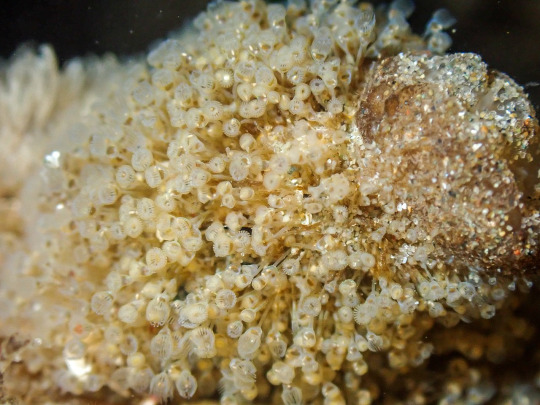
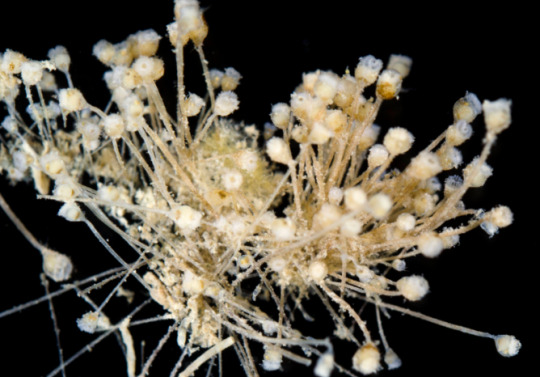
82 notes
·
View notes
Text
Phylum #22: Entoprocta, the goblet worms!


Despite their looks, these are not sea anemones, crinoids or bryozoans - these creatures have in fact been found to be mollusks' closest relatives! Although this part of the tree of life is in flux, entoproctan larva share the peculiar nervous system of mollusks, leading researchers to unite both in a single clade!
Entoproctans or kamptozoans, often referred to as goblets due to their stalked cup-like form, have a much simpler body plan than their relatives. A crown of tentacles at the top of the cup beats to bring a current through the U-shaped gut inside, passively filtering food particles. And that's it!
Goblets often live in massive colonies, with new ones budding from the stalks of previously-established ones. These stalks actually serve a triple function, also extending the reach and allowing them to share nutrients. However, a few species are free-living and solitary, crawling with their foot (their equivalent of the stalk), hitching a ride on other animals, or even jumping over!


#forms and phyla#entoprocta#kamptozoa#goblet worms#goblets#tetraneuralia#marine biology#marine life#and this tag will make sense much later#bryozoa
82 notes
·
View notes
Text
Phylum #21: Mollusca!

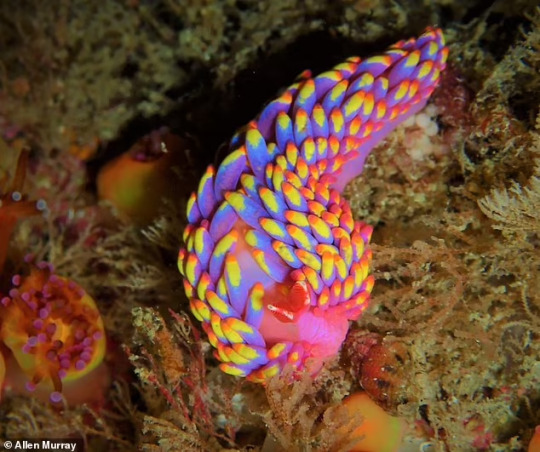
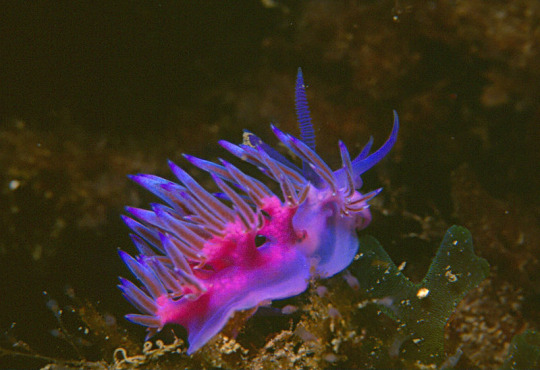
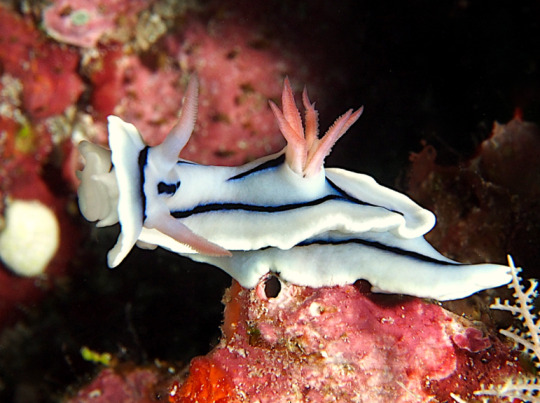
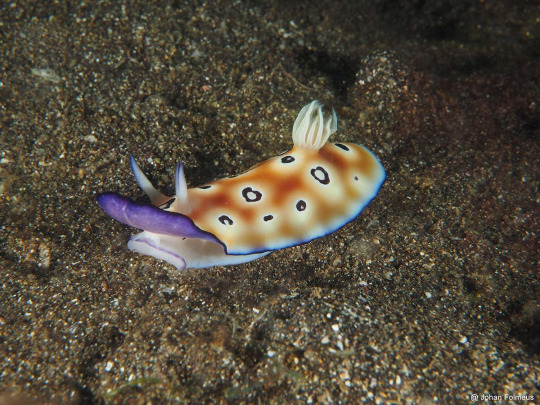
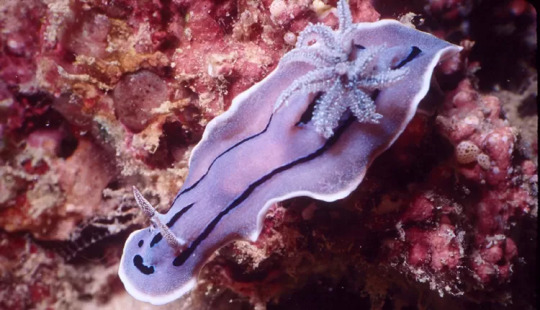
The second-largest phylum after arthropods, molluscs come in a massive variety of shapes and colors, having successfully colonized virtually every marine environment, and many freshwater and terrestrial ones. From armored chitons with hundreds of eyes embedded in their plates, to colorful nudibranchs, to fluffy-looking solenogastres, it is hard to see at first sight that they all make up a single clade.
In fact, relatively few characteristics unite all mollusks! While the hypothetical ancestral mollusk - likely a limpet-like creature - had an unsegmented shell, many mollusks derived it into an articulated or hinged shell, or lost it entirely.
All mollusks are united by a fleshy mantle covering the body, and, except bivalves, a toothed tongue or radula, used as a rasping tool to process food. The foot is also a recurring characteristic, although often highly derived - in cephalopods like squid and octopus, it has in fact evolved into their many tentacles!
Mollusks also show a pretty intriguing nervous system. Instead of a single brain, they show a series of ganglions, encircling the oesophagus and functioning in a decentralized way. In cephalopods, many of them fused into a central brain, although most, still in the tentacles, can act independently from the "brain", leading to a complex and alien intelligence in creatures known for building underwater cities!
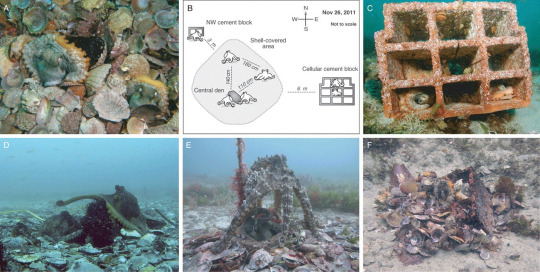
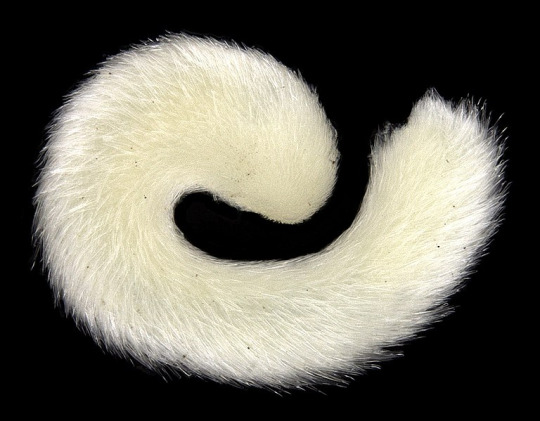

162 notes
·
View notes
Text
Phylum #21: Mollusca!






The second-largest phylum after arthropods, molluscs come in a massive variety of shapes and colors, having successfully colonized virtually every marine environment, and many freshwater and terrestrial ones. From armored chitons with hundreds of eyes embedded in their plates, to colorful nudibranchs, to fluffy-looking solenogastres, it is hard to see at first sight that they all make up a single clade.
In fact, relatively few characteristics unite all mollusks! While the hypothetical ancestral mollusk - likely a limpet-like creature - had an unsegmented shell, many mollusks derived it into an articulated or hinged shell, or lost it entirely.
All mollusks are united by a fleshy mantle covering the body, and, except bivalves, a toothed tongue or radula, used as a rasping tool to process food. The foot is also a recurring characteristic, although often highly derived - in cephalopods like squid and octopus, it has in fact evolved into their many tentacles!
Mollusks also show a pretty intriguing nervous system. Instead of a single brain, they show a series of ganglions, encircling the oesophagus and functioning in a decentralized way. In cephalopods, many of them fused into a central brain, although most, still in the tentacles, can act independently from the "brain", leading to a complex and alien intelligence in creatures known for building underwater cities!



#forms and phyla#mollusca#mollusk#pride flag#marine life#marine biology#lesbian nudibranch#a lot of pride nudibranchs actually#and octopus cities
162 notes
·
View notes
Text
Phylum #20: Gnathostomulida, the jaw worms!
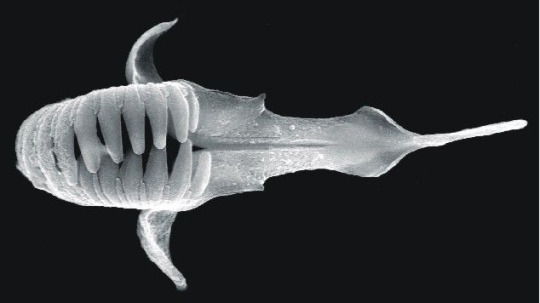
Truly, all four gnathiferan phyla deserve the name of "jaw worms". They're worms (which as far as bilaterians go is pretty much a "default" category), and they have jaws. But the minute gnathostomulids are, in a way, the simplest, most archetypal "worms with jaws".
At most a millimeter long, adapted to live in shallow marine sediments, jaw worms are a typical component of the meiofauna. Which means, no need for futilities like a respiratory or circulatory system - cellular diffusion is more than enough! Even the digestive tract has been simplified, with no anus to be found.
With half of their body dedicated to sex organs, their reproduction strategy has to be peculiar. Fertilize each other (they're hermaphrodites!), produce an egg, and rupture the body wall to let it out. And patch the resulting wound as if it was nothing. Yes, they're that badass.
What about their fearsome jaws? Well, they'd much smaller than you'd imagine. In fact, their snout covered in whiskers-like cilia is much more visible. These are their only sense organs, with which they find prey before scooping them up with their basal plate and catching them with the other two jaws!
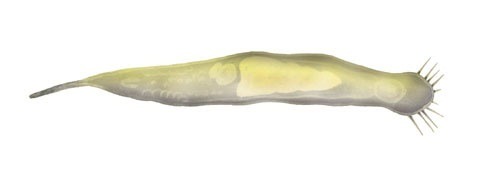
77 notes
·
View notes
Text
Phylum #20: Gnathostomulida, the jaw worms!

Truly, all four gnathiferan phyla deserve the name of "jaw worms". They're worms (which as far as bilaterians go is pretty much a "default" category), and they have jaws. But the minute gnathostomulids are, in a way, the simplest, most archetypal "worms with jaws".
At most a millimeter long, adapted to live in shallow marine sediments, jaw worms are a typical component of the meiofauna. Which means, no need for futilities like a respiratory or circulatory system - cellular diffusion is more than enough! Even the digestive tract has been simplified, with no anus to be found.
With half of their body dedicated to sex organs, their reproduction strategy has to be peculiar. Fertilize each other (they're hermaphrodites!), produce an egg, and rupture the body wall to let it out. And patch the resulting wound as if it was nothing. Yes, they're that badass.
What about their fearsome jaws? Well, they'd much smaller than you'd imagine. In fact, their snout covered in whiskers-like cilia is much more visible. These are their only sense organs, with which they find prey before scooping them up with their basal plate and catching them with the other two jaws!

77 notes
·
View notes
Note
is Gnathostomulida next? it sure seems like it is with it being the only gnathiferan group that hasn’t been covered
Yes, they're coming today! I'm arranging the posts as a flattened phylogenetic tree, so related clades always end close to each other! Although for the next ones, lophotrochozoan phylogeny is still pretty much in flux so I'll see which ordering I go for (probably Marlétaz et al. 2019)
1 note
·
View note
Text

28 notes
·
View notes
Text
Phylum #19: Micrognathozoa!
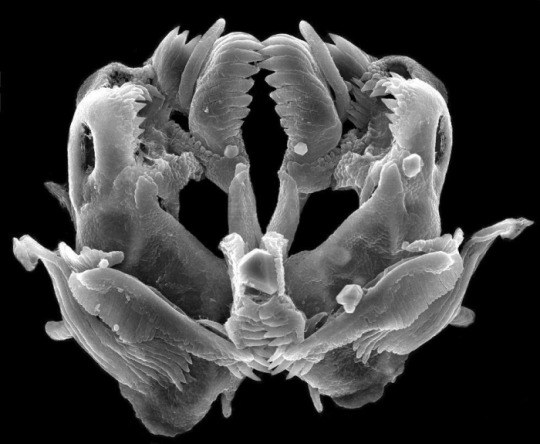
Why have a pair of jaws when you can have a fifteenuple of them? This microscopic but extremely intricate system of jaws is definitely the star of today's species, Limnognathia maerski. Yes, species. Found in both Greenland and Antarctica, this tiny creature is the only one known in its entire phylum, Micrognathozoa!
Only discovered in the year 2000, the still little-known Limnognathia shows a body plan like no other. On top of the intricate system of jaws - making it likely a gnathiferan, cousin to arrow worms and rotifers -, an accordion-like thorax links its head and abdomen, the latter ending in a transient anus.
Swimming in spirals with the help of ciliated cells and anchoring itself with an adhesive pad, Limnognathia feeds on bacteria, diatoms and other micro-organisms. As the ventral jaws snatch the prey, they are brought to the main jaw system to be chewed and digested.
Limnognathia's life cycle is still poorly known. Only the youngest specimens found displayed male organs, leading researchers to believe them to be sequential hermaphrodites - changing from male to female during their life cycle. The peculiar distribution around both poles, with most specimens recovered from a single cold spring in Greenland, hints at it being a relict from the Cretaceous, when Greenland was still a tropical reef.
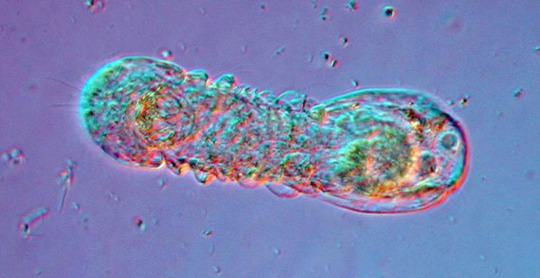
#forms and phyla#micrognathozoa#limnognathia#bioblr#hermaphroditism#cretaceous#greenland#kalaallit nunaat#antarctica
45 notes
·
View notes
Text
Phylum #18: Rotifera, the wheel animals!
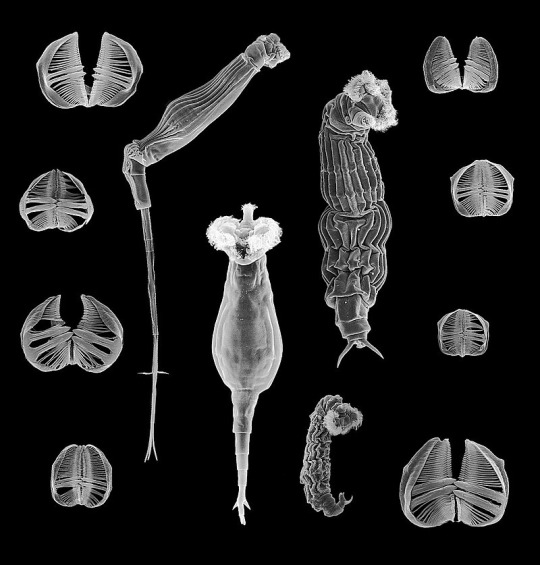
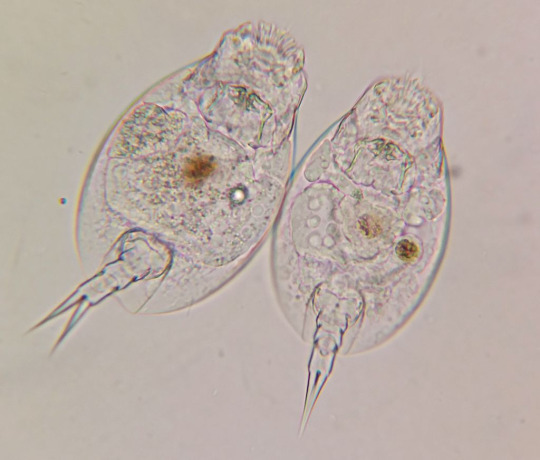
Another phylum of little-known, inconspicuous creatures, "wheel animalcules" have chiefly made their living in most of the world's lakes and rivers. But, hidden in holdfasts or thawed from the permafrost, tiny rotifers conceal an unexpected diversity of shapes and ecologies.
Bdelloids are the most well-known rotifers, and a good model to understand their anatomy. Their simple, elongated body, covered in a cuticle, ends in an articulated tail-like "foot". Their mouth anatomy is much more interesting, with a set of elaborate jaws, the mastax, allowing them to grab onto prey. The corona, a ring of cilia surrounding the mouth, moves to create a feeding current, with the appearance of a rotating wheel giving the phylum its name.
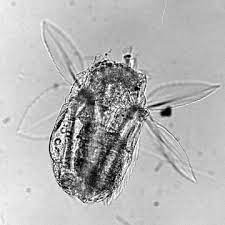
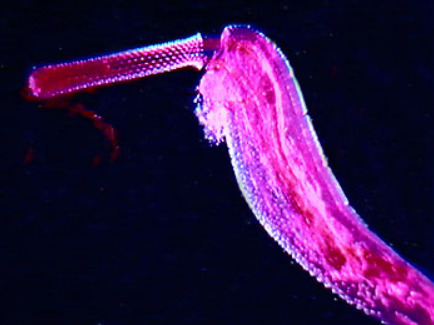
Of the three other clades of rotifers, seisonids are the earliest to have diverged, with these crustacean parasites evolving into a peculiar long-necked profile. Monogonontans are often less elongated, with genera like Polyarthra using wing-like paddles to swim through water. Historically recognized as a separate phylum, acanthocephalans were only recently recognized as highly modified rotifers, also adapted to a parasitic existence.
Although many rotifers swim freely in either freshwater or saltwater, some have adopted a sessile lifestyle, while others occupy the liminal film of moisture covering mosses and soil. Most unique are the colonial rotifers, massive spheres of hundreds or even thousands of individuals drifting together, coronas facing outwards, to filter microscopic food.

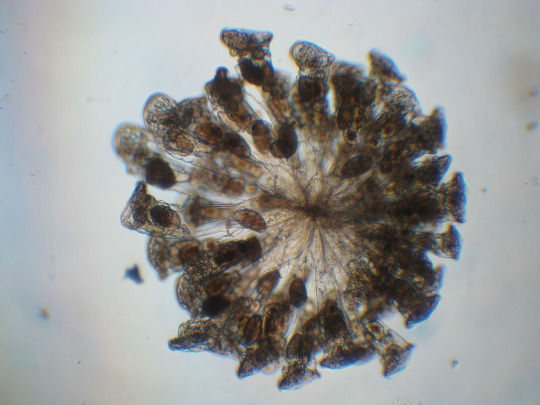
69 notes
·
View notes
Text
Phylum #18: Rotifera, the wheel animals!


Another phylum of little-known, inconspicuous creatures, "wheel animalcules" have chiefly made their living in most of the world's lakes and rivers. But, hidden in holdfasts or thawed from the permafrost, tiny rotifers conceal an unexpected diversity of shapes and ecologies.
Bdelloids are the most well-known rotifers, and a good model to understand their anatomy. Their simple, elongated body, covered in a cuticle, ends in an articulated tail-like "foot". Their mouth anatomy is much more interesting, with a set of elaborate jaws, the mastax, allowing them to grab onto prey. The corona, a ring of cilia surrounding the mouth, moves to create a feeding current, with the appearance of a rotating wheel giving the phylum its name.


Of the three other clades of rotifers, seisonids are the earliest to have diverged, with these crustacean parasites evolving into a peculiar long-necked profile. Monogonontans are often less elongated, with genera like Polyarthra using wing-like paddles to swim through water. Historically recognized as a separate phylum, acanthocephalans were only recently recognized as highly modified rotifers, also adapted to a parasitic existence.
Although many rotifers swim freely in either freshwater or saltwater, some have adopted a sessile lifestyle, while others occupy the liminal film of moisture covering mosses and soil. Most unique are the colonial rotifers, massive spheres of hundreds or even thousands of individuals drifting together, coronas facing outwards, to filter microscopic food.


69 notes
·
View notes
Text
@darkwinnerlampzonk Took a little delay, but it's there!
Phylum #17: Chaetognatha, the arrow worms!

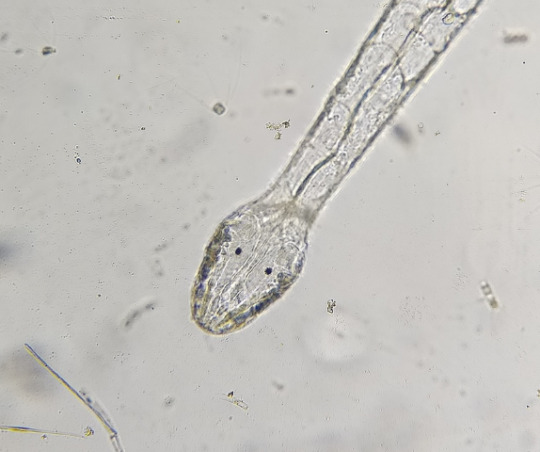

Ubiquitous in all of Earth's oceans, small, transparent arrow-shaped creatures are always on the hunt, darting towards their prey with a single stroke of their tail fin. While little-known, chaetognaths, or arrow worms, constitute a huge part of Earth's plankton, from the deep seafloor to shallow estuaries.
Arrow worms are gnathiferans, a clade characterized by a set of complex jaws made of chitin: here, several pairs of grasping spines surrounding their mouth! Nearly always ambush predators, many species sport the deadly tetrodotoxin, which they use to subdue their prey. Arrow worms show some variation in ecology, with some benthic species attaching to rocks or algae or hiding in sand grains!
Like fish, their elongated body sports one or several pairs of lateral fins, either partially or fully rayed, as well as a tail ending in a caudal fin. While very convergent, their body plan is slightly different as they swim by undulating top-to-bottom, rather than side-to-side like fish, explaining the horizontal position of their fins.
While arrow worms can reach up to 12 centimeters in length, they are often much smaller. While their size is limited by their lack of a respiratory system and of a complex circulatory system, requiring them to be small enough so that diffusion can take place. In spite this, their efficient body plan has made these little-known creatures some of the most successful predators in Earth's oceans.
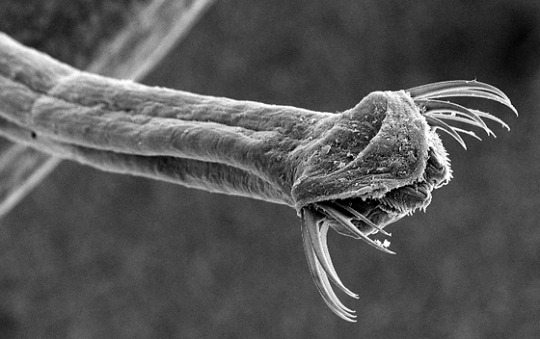
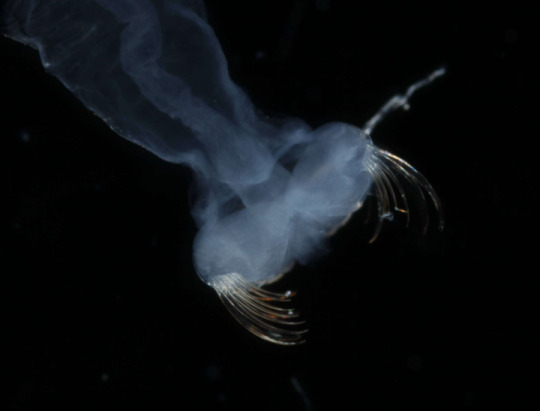
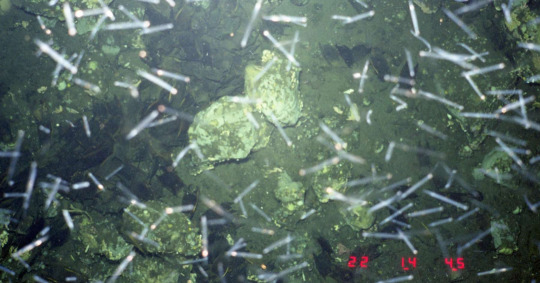
104 notes
·
View notes